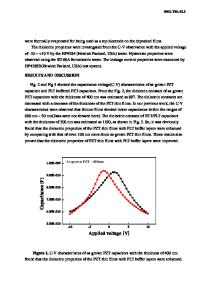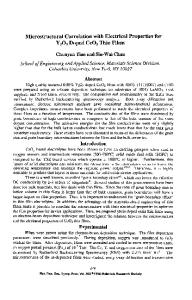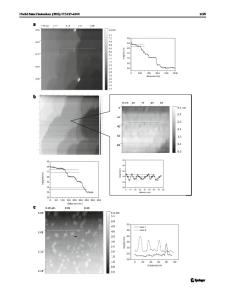CeO 2 Thin Films as Buffer Layers for Si/YBCO Integrated Microelectronics
- PDF / 250,471 Bytes
- 6 Pages / 612 x 792 pts (letter) Page_size
- 0 Downloads / 316 Views
G3.9.1
CeO2 thin films as buffer layers for Si/YBCO integrated microelectronics Elena TRESSO, V. Ballarini, A.Chiodoni, R.Gerbaldo, G.Ghigo, L.Gozzelino E.Mezzetti, B.Minetti, C.F.Pirri, INFM-UdR ToPoli and Politecnico of Torino (ITALY) G.Tallarida, S.Ferrari, INFM-Laboratorio MDM (ITALY) C.Camerlingo, C.N.R., Istituto di Cibernetica, Pozzuoli (Na), (ITALY) INTRODUCTION The unique properties of superconductors such as radiation hardness and high microwave performances [1-3] make the integration with semiconductor conventional electronics a stimulating challenge. Many attempts have been tried to obtain good quality YBa2Cu3O7-x (YBCO) films on Si substrates, with the aim of taking advantage from the properties of both materials, but interdiffusion reactions and a poor lattice and thermal expansion coefficient matching require the use of a buffer layer at the semiconductor/superconductor interface. Yttria-stabilized zirconia (YSZ), Y2O3, MgO, SrTiO3, CeO2 and their combinations have been proposed and used as buffer layers in the case of Si/YBCO systems [4-10]. In this paper we will present results concerning the deposition and the study of Si/buffer-layer system, when conventional substrates, magnetron sputtering technique and post-deposition annealing treatments are employed. Goal of our work is the optimization of the Si/buffer-layer/YBCO multilayer deposition processe, in order to grow superconducting films of quality suitable for device applications. Among the possible buffer layers, we chose ceria (CeO2). CeO2 has a cubic structure with a lattice parameter of 5.41 Å, very close to that of Si (5.43 Å), as well as to the diagonal of the YBCO a-b plane [11]. Furthermore its thermal expansion coefficient is intermediate to that of Si and YBCO. These characteristics make CeO2 very promising material as a buffer layer. However the growth of a suitable CeO2 film on silicon is a critical issue: a proper control of film structure and of CeO2/Si interface is required [6]. As substrate we chose Si (100) because of its reliability in silicon-based technology. We have deposited different sets of polycrystalline CeO2 films on Si(100) substrates, by RF magnetron sputtering of CeO2 targets in Ar atmosphere. Deposition parameters such as RF power, pressure, distance target-substrate, and pre-deposition treatment procedures have been optimized in order to obtain good quality Si/CeO2 bilayers: in partial agreement with previous literature [12], we found that it is possible to grow, on silicon (100) substrate, (111) oriented, stoichiometric, relatively thick CeO2 films, whose flat, well-textured surfaces are reproducible [13,14]. In this paper we report on annealing treatments performed on such Si/CeO2 bilayers. A set of optimized samples with deposition temperatures ranging from 100°C to 800°C has been radiatively heated at two different annealing temperatures, in N2 and O2 atmospheres. All the samples have been characterized by X-ray diffraction, Atomic Force Microscopy, micro-Raman spectroscopy. The preferential grain orientation
Data Loading...











